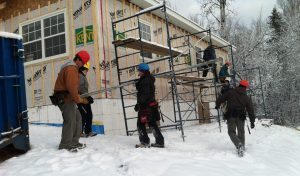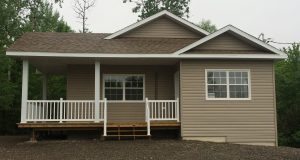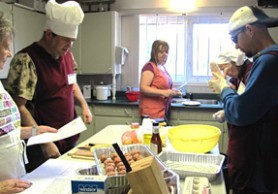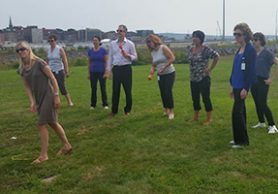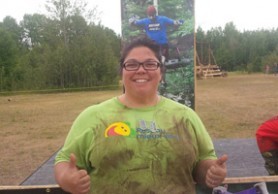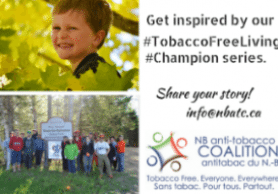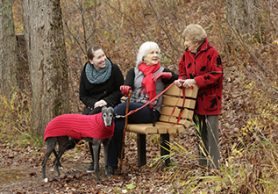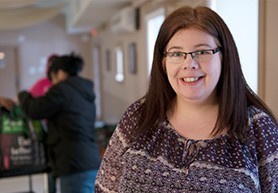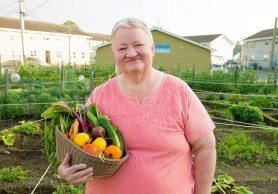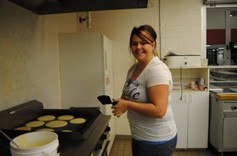Stories of inspiration
from people just like you...
How college students are building their mental fitness by building homes for families in need


At CCNB Edmundston, students are hard at work learning their trades. But they’re not just working on a regular school project – they’re building a house that will become a home for a local family in need. Thanks to two passionate teachers and their innovative idea, students are taking their training to the next level by laying down the foundation for their own mental fitness. Through a partnership between the College and Habitat for Humanity and with the collaboration and support from the community, each year, students are building a house – from the ground up! And the best part of this is that once construction is complete, they can feel good about the contribution they made to their community and to one family in particular.
“This project really touches the students because they’re building something that will last,” says Guillaume Bernard, carpentry teacher at CCNB Edmundston. “There’s real pride in knowing a family will benefit from the work they do and this means they come to ‘school’ each day excited to get started and their workmanship is of the best quality.”
The project is the realization of a dream Guillaume has had for decades. It started small, with a project to build a gazebo that was raffled off for charity. The fundraiser included inviting the community to come watch the gazebo be erected live! It was a huge hit. This first success led to a second opportunity right at CCNB. The college needed a warehouse to store all the building materials used for courses, so instead of contracting the work out, Guillaume and some of his colleagues pitched the idea of having the students build the warehouse. It was another rousing success!
The gazebo and the warehouse proved to both the college and the students themselves that they were capable of doing high-quality, professional work, but the dream of having them build a real house still faced a few hurdles. The college had restrictions, in terms of their budget and governance, which made it impossible for them to take on the project on their own.
The magic happened when Habitat for Humanity heard about CCNB’s desire to have their students build houses and came forward with a partnership offer – CCNB would provide the labour and expertise, and Habitat for Humanity would provide the financing and work with the Department of Social Development to identify a family in need to receive the home. Several community sponsors and local businesses also stepped forward to donate materials like wood, tiles, vinyl and flooring to help in the construction. Contractors gave their time and experience to ensure everything was inspected properly. “These contractors volunteered their time to work with students and certify that the work was up to code. It’s amazing to get this kind of support from these professionals,” explains Guillaume.
Since 2014, students from Carpentry, Electrical, Civil Engineering, Woodworking and Heating, Air Conditioning and Refrigeration are now learning their trades in a hands-on environment, which offers tremendous benefits, but also brings its own set of challenges.
“It’s very realistic. They’re really living the experience,” says Guillaume. “We work outside in all kinds of conditions. Last year we had rain, snow, freezing weather, you name it.” Being on site means that lessons that might never make it into the classroom, like how to dress for certain weather conditions and what to eat to maintain energy, are taught organically.
It also means that students regularly face challenges that they have to overcome together, which helps develop their feeling of belonging or relatedness and being part of the decision-making process means they build their autonomy. “A lot of these students are young and haven’t really had to face a challenge on their own so far,” says Guillaume. “Up to this point in their lives their parents were able to step in for them when there was a problem, or if they didn’t finish a school assignment, the only consequence was a low grade. When they are on the site, everyone has to step up and have a voice in solving real-life problems. We push them, and they really rise to the challenge and grow. And this is a wonderful transformation to witness.”
One of the biggest changes Guillaume has seen as a result of the program is how students grow their confidence by getting confirmation of their chosen field, and realize that their contribution matters. For some of the students, who might not do well in a classroom setting, their competence shines when they contribute their own skills and experience to the project. “It really makes them proud to build something that will last, as opposed to doing an exercise in the classroom knowing that it will get torn down after. They get on the site and they want to learn. We get to see them evolve over the year.”
The interactions amongst students and between students and instructors are quite different too. At the college, lunch might be spent on phones or hanging out with friends from other programs, whereas lunches on site mean everyone sits together, eating their sandwiches and talking. “A real sense of camaraderie develops,” notes Guillaume. “We become one team.”
And the instructors work right next to the students, mentoring them as they go. “If they run into difficulty, I teach them tricks on how to do things more efficiently but I also ask them for their ideas and get to try it out with them.” Guillaume says it has also benefitted the instructors who are thinking outside the box more, which is helping the program evolve.
In the end, these students build more than just a house. They’re building their mental fitness too! They build their competence by growing their skills and experience; their autonomy by sharing their ideas and being involved in decision-making; and their relatedness by creating stronger relationships with each other. Through this experience, the students get to see the value of their work and feel like they are an important part of their class, their college and their community.
And while the project is still evolving, Guillaume is convinced there’s nowhere to go but up. “We started by building a gazebo but dreaming of a house, now we’re building houses and dreaming about creating new, energy-efficient designs. And the best part is that we are building houses for people from our own community that would otherwise never get to know the feeling of being a home owner, and this helps them to integrate better into the community.”
One thing is for certain – this project gives as much back to the students as it does to the community! And it not only helps train future professionals, it helps develop resilient and mentally fit young adults.
Related websites and resources…
Infographic – What is Mental Fitness?
Portrait of Mental Fitness – the CAR approach
Infographic – What is the CAR Approach to Mental Fitness?
Feeling inspired?
Well it's time to take the next step! Find the resources you need to start your wellness story here!

